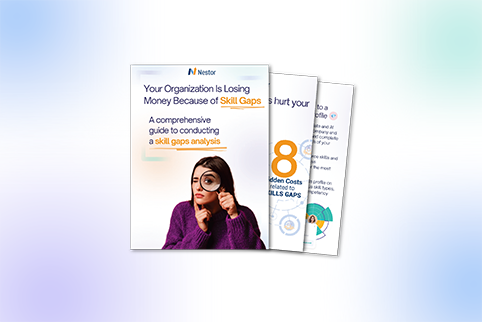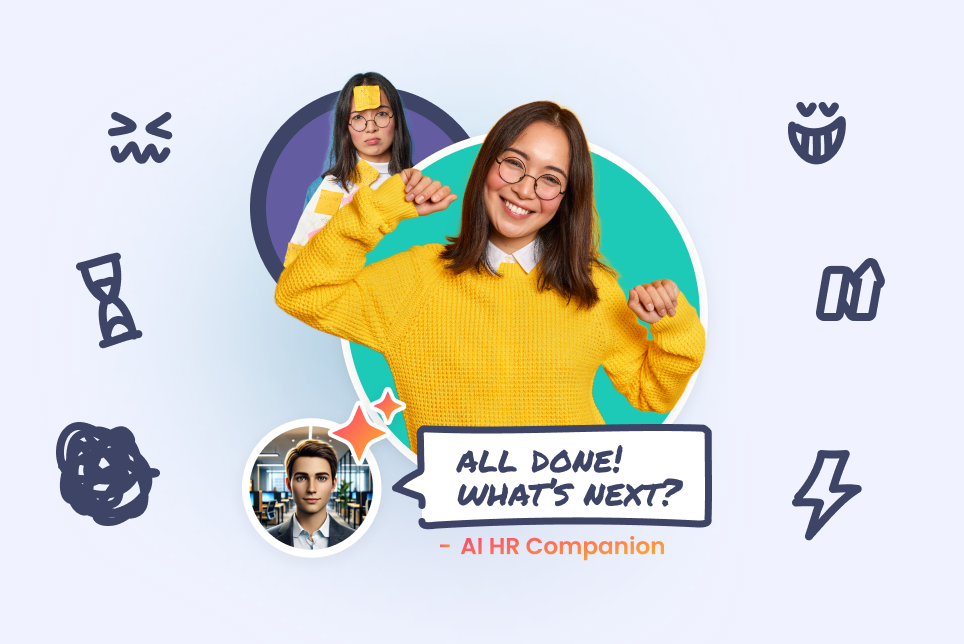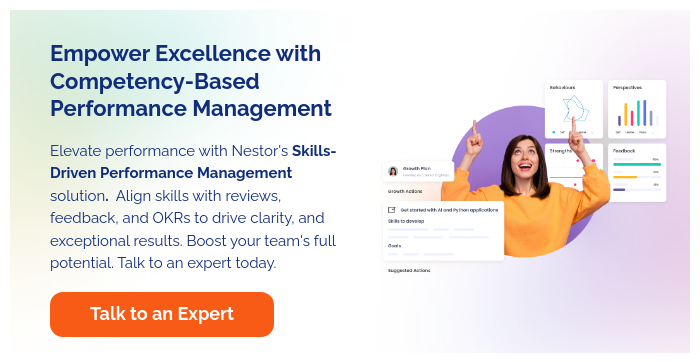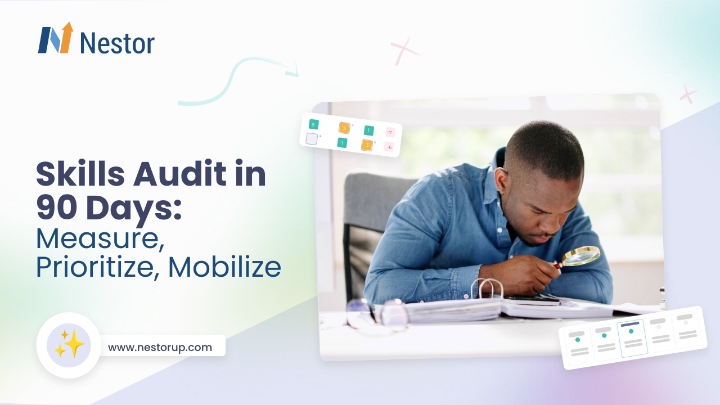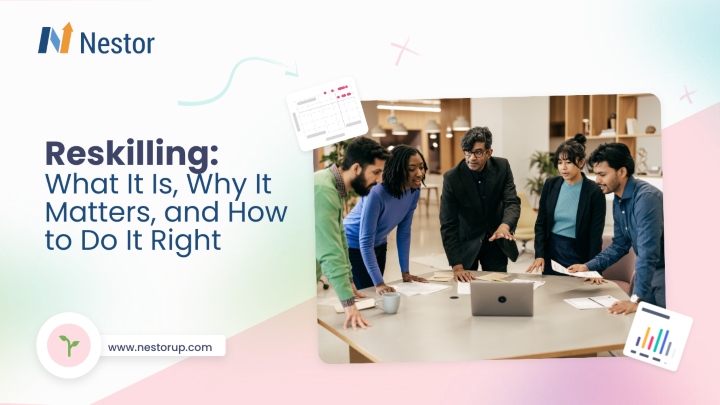
Contents
Do You Really Understand Competencies Meaning? Most Don’t.
A lot of professionals talk about competencies as if they’re just another word for skills. Even within HR teams, the terms are often used interchangeably. It sounds harmless, until it starts to affect hiring, development, and the way we prepare people for the work ahead.
Because that’s exactly what’s happening.
The misunderstanding around competencies meaning is more than a vocabulary issue. It’s creating blind spots in how we identify talent, how we shape career paths, and how we adapt job roles in response to new tools and technologies; especially artificial intelligence. Many organizations are working hard to upskill their workforce, but if you’re working off the wrong definition, you might be reinforcing the wrong things.
Competencies aren’t just about what people can do. They’re about how they approach their work. What behaviors they bring. What values guide their decisions. And whether they can keep performing when the context changes. That last part matters more than ever now that AI is entering roles that used to be fully human.
This article is for HR leaders who are rethinking how jobs are structured, how teams are built, and how talent is developed. It’s about understanding competencies meaning, and why it should be a part of your strategy, not just your vocabulary.
We’ll break down the difference between skills and competencies in simple terms. We’ll look at how this impacts your day-to-day work; whether you’re hiring, building a framework, or rolling out a new learning strategy. And we’ll connect it to where work is heading: a future where AI handles more of the technical tasks, and people need to bring something else to the table.
Not more skills. More clarity.
Let’s start with the basics. What do we actually mean when we say “competency”? And why does that definition matter right now?
What Are Competencies? (Definition and Meaning)
Defining Competencies
Understanding the competencies meaning it’s essential. Especially now, as organizations try to prepare their people for shifting roles, new technology, and changing expectations. Competencies offer a more complete view of what drives success at work. They allow teams to go beyond tasks and see the full capacity of an individual in context.
Actually, the concept of competencies has been around since the 1950s, but it gained real traction in 1973 when Harvard psychologist David McClelland challenged the reliability of traditional intelligence tests in predicting job success.
He proposed a different approach, focusing on the personal attributes and behaviors that actually drive high performance. This led to the creation of competency models: tailored frameworks that define what’s expected for someone to perform effectively in a specific role or context.
That’s why we can assure you that competencies are not made to replace what already works. They strengthen it. They provide structure around job roles by showing how different qualities interact to shape real-world performance. This is where many HR strategies miss the mark: they stop at skills. But skills alone don’t guarantee success. Context does. And that’s exactly what competencies offer.
A competency brings together knowledge, skills, abilities, and behaviors in a way that reflects how someone performs, adapts, and grows in a specific role. It’s not theoretical; it’s applied. It shows how a person carries out their work, not just what they know how to do.
When organizations align on this, they stop asking just, “Does this person have the right skill?” and start also asking, “Can this person handle what this role actually demands?” That small shift makes a big difference.
Core Components of Competencies
Every competency is made up of four parts that work together. Think of them less like isolated pieces and more like forces that interact in real situations. When they’re aligned, you get reliable, adaptable performance.
Here’s how they break down:
1. Knowledge
What someone understand: the facts, frameworks, processes, and context they’ve absorbed over time. This can come from formal training, hands-on experience, or continuous learning. It gives direction to action.
Example: A payroll specialist understands local tax laws, benefits policies, and system workflows.
2. Skills
What someone can do. These are learned capabilities, often tied to tools, platforms, or procedures. Skills get things done, but on their own, they don’t explain how someone adapts or interacts.
Example: A recruiter knows how to screen applications, write job descriptions, or use an ATS effectively.
3. Abilities
How someone thinks, reacts, or processes. These are more internal, like critical thinking, emotional regulation, or memory. Abilities affect how well someone applies their knowledge and skills under real pressure.
Example: An HR generalist stays composed during heated discussions, quickly reads social dynamics, and adjusts their tone accordingly.
4. Behaviors
What you actually see. Behaviors reflect how everything else plays out in real situations. They show alignment with culture, accountability, communication style, and decision-making in motion.
Example: A people manager addresses conflict early, provides feedback clearly, and builds trust across levels.
Visualizing Competencies
Think of competencies as a formula:
Competency = Knowledge + Skills + Abilities + Behaviors
A truly competent professional doesn’t just possess isolated capabilities but demonstrates how these elements work together seamlessly in practice. For instance, a competent project manager doesn’t just know project management methodologies (knowledge) and can use project management software (skill), but also demonstrates problem-solving abilities and exhibits behaviors like adaptability and stakeholder management in real-world scenarios.
Leadership as a Competency
Let’s take leadership. Not as a title, not as a set of tasks, but as a competency.
Leadership includes things like:
- Clear communication
- Responsible decision-making
- Emotional awareness
- Delegation
- Vision-setting
- Navigating complexity
- Earning trust
All of these are valuable on their own. But together, they form the leadership competency. That’s what allows someone to step into uncertainty, rally a team, and move an organization forward.
Someone might speak well in meetings or manage projects smoothly; both great skills. But unless they also show accountability, handle setbacks well, and earn follow-through from others, they’re not practicing leadership in full.
That’s the value of competencies. They go beyond the task list and into how a person shows up when it counts.
Other Real-World Examples of Competencies
To further clarify what competencies look like in practice, consider these examples:
Strategic Thinking
- Knows industry shifts, organizational goals, and business implications
- Can evaluate options, work with data, and prioritize effectively
- Is able to connect patterns, weigh risks, and stay focused in uncertainty
- Shows curiosity, forward focus, and alignment with long-term strategy
Strategic thinking isn’t a separate job. It sharpens leadership, informs planning, and helps mid-level managers make better calls under pressure.
Change Management
- Knows what makes change succeed or fail; models, people factors, timing
- Can build buy-in, explain the why, and adjust the message
- Is able to sense resistance early, adapt, and support people through discomfort
- Shows clarity, patience, and steady follow-through even when plans shift
This competency doesn’t live in a silo. It supports HRBPs, L&D teams, and department leads who guide teams through restructuring, tool rollouts, or shifts in process.
Customer Experience Excellence
- Knows the product, customer journey, and service principles
- Can listen, solve, and communicate clearly
- Is able to stay grounded under pressure and switch gears fast
- Shows care, patience, and ownership, even when dealing with unhappy customers
It’s not just a front-line skill. This competency improves brand trust, helps retain clients, and gives internal teams insights they can act on.
Skills vs. Competencies: What’s the Difference?
To truly understand competencies, we need to clearly distinguish them from skills. While these two terms are often used interchangeably, they refer to distinct aspects of performance and development. Here’s a breakdown of the key differences:
Definition: Specific vs. Integrated
Skills refer to specific learned abilities that allow an individual to perform particular tasks. These are focused, often technical abilities that can be demonstrated quickly. For example, knowing how to use Excel to create financial models is a skill.
On the other hand, competencies are broader and represent an integrated set of skills, knowledge, abilities, and behaviors that contribute to overall effectiveness in a role. For example, financial analysis is a competency because it involves using specific skills (like using Excel), combined with knowledge of finance, and the ability to analyze and interpret data in real-world situations.
Scope: Narrow vs. Broad
The scope of skills is narrow and specific. Skills focus on performing a particular task or function. They are generally defined and measurable, like coding in Python or designing a website.
In contrast, competencies are broad and multifaceted. A competency takes into account how well someone performs across a variety of situations and tasks.
Measurement: Easier vs. More Complex
Skills are typically easier to measure. You can test or observe someone performing a task to gauge their level of proficiency. It’s straightforward: can they perform the task or not?
Competencies, however, are more complex to measure. Since they involve a combination of skills, knowledge, abilities, and behaviors, assessing them requires ongoing observation and evaluation over time. You need to see how an individual applies all these elements together in different situations, not just whether they can perform one specific task.
Development Timeline: Quick vs. Long-Term
Skills can often be developed quickly. With practice and training, individuals can become proficient in a skill in a relatively short amount of time. For example, learning how to use a new software tool or mastering a particular coding language can be done within a matter of weeks or months.
Competencies, on the other hand, take longer to develop. They represent a more comprehensive understanding and the ability to apply multiple elements (knowledge, skills, abilities, and behaviors) over time. Developing a competency, like strategic thinking or change management, requires experience and reflection on real-world challenges, which means it typically takes years to develop fully.
Transferability: Easy vs. Context-Dependent
Skills tend to be more transferable across different jobs and environments. A skill like coding in Python can be applied to various roles, industries, and contexts. Similarly, the ability to use Microsoft Excel is useful in finance, marketing, HR, and many other areas.
Competencies, while they can sometimes be transferable, are often more context-dependent. Some competencies, like leadership, are applicable across many different settings, but others, like customer service excellence, may look different depending on the specific industry or organizational culture. While you can carry the idea of leadership from one job to another, the way you demonstrate it might vary depending on the environment and expectations.
The Recipe vs. Ingredients
To put it simple, think of it this way: Skills are ingredients. Competencies are the whole recipe.
You might have flour, sugar, eggs, and milk (all skills), but that doesn’t automatically mean you can create a delicious cake (the competency). The competency includes knowing when and how to combine the ingredients, understanding the baking process, troubleshooting when things go wrong, and presenting the final product effectively.
Similarly, a professional might have programming skills, writing skills, and analytical skills, but the “product management competency” involves knowing how to integrate these skills at the right moments, with the right stakeholders, to deliver successful products.
Key Distinctions to Remember
Skills are often task-based, measurable, and short-term. They answer the question, “Can you do this specific thing?” Skills have clear parameters and can often be tested or demonstrated in isolation. For example, coding in Python, operating a forklift, or writing professional emails are all discrete skills.
Competencies are holistic, behavior-focused, and long-term. They answer the question, “Can you perform effectively in this role or situation?” Competencies are demonstrated through patterns of behavior and overall effectiveness in complex situations. For example, innovation, customer orientation, or strategic thinking are competencies that manifest across various activities.
“It’s Not Skills OR Job Roles”
Many organizations fall into the trap of thinking they must choose between skill-based approaches or traditional job role frameworks. This is a false dichotomy. The most effective talent management strategies recognize that:
- Job roles are composed of required competencies
- Competencies are built from clusters of related skills
- Skills have varying proficiency levels
Each layer provides valuable information and serves different purposes in talent management.
Why People Get Confused: Common Misconceptions
The confusion around competencies and skills is widespread and persistent. Here are some of the most common misconceptions:
“If I have a skill, I’m competent.”
This is probably the most frequent assumption. Knowing how to do something doesn’t automatically make someone competent in a role. Skills are part of the equation, but they’re not the whole story.
Competence means knowing how, when, and why to use those skills in real-world situations. It involves context, judgment, and consistency over time. You might be excellent at writing code, but if you struggle to collaborate, can’t align with user needs, or don’t adapt to business priorities, your effectiveness in a software development role will be limited.
A person can be technically brilliant and still miss the mark when it comes to delivering value through their work.
“Skills define my job.”
It’s tempting to describe your work by listing tools or tasks you know: graphic design, budgeting, writing reports, etc. But jobs aren’t built around isolated skills. They rely on how you combine those skills to solve problems, adapt to challenges, and deliver outcomes.
You can know how to use marketing software and still miss the mark as a marketer if you don’t understand your audience, think strategically, or know how to turn data into insight. It’s not about replacing skills; it’s about building on them. You reinforce your role by learning how to apply those skills in more meaningful ways.
“Competencies are just corporate language.”
Some roll their eyes at the word “competency,” assuming it’s another empty term buried in HR presentations. That reaction is understandable; especially when competencies aren’t clearly defined or connected to real outcomes. But when done right, competencies bring structure and clarity to performance.
They help organizations make smarter hiring decisions, guide professional development, and ensure people are working toward goals that matter. More importantly, they make it easier for employees to grow in their roles, not by replacing what they already know, but by giving it direction and purpose.
Why These Misconceptions Matter
These misconceptions aren’t merely academic; they have real consequences:
- Poor career planning: Focusing only on skills acquisition without developing broader competencies can lead to career stagnation.
- Misaligned hiring: Organizations that hire solely for skills without assessing competencies often face integration and performance issues.
- Ineffective development programs: Training programs that target only skill development without addressing behavioral components of competencies deliver lower return on investment.
- Reduced organizational agility: Companies that can’t differentiate between skills and competencies struggle to adapt to changing demands and redeploy talent effectively.
That’s why we believe it’s time to bring clarity and action to the conversation around skills and competencies. The distinction isn’t just semantics; it’s essential for effective talent management.
A New Way to Look at Skills: Layers of Proficiency
To further complicate (and enrich) our understanding of skills and competencies, we need to recognize that skills themselves aren’t binary attributes. They exist on a continuum of proficiency.
Skills Have Levels
The “have it or don’t have it” view of skills is fundamentally flawed. In reality, skills exist along a spectrum of mastery:
Beginner: Basic understanding and application in straightforward situations
- Can follow instructions and complete simple tasks with guidance
- Still learning fundamental concepts and terminology
- Limited experience applying the skill in real-world scenarios
Intermediate: Working knowledge and independent application
- Can apply the skill independently in standard situations
- Understands core principles and common variations
- Has some experience but may need support in complex cases
Advanced: Deep knowledge and adaptable application
- Can handle complex and novel situations
- Can teach or guide others in applying the skill
- Understands nuances and exceptions
Expert: Authoritative knowledge and innovative application
- Can develop new approaches or methods within the skill area
- Can handle the most challenging applications
- Often contributes to the evolution of the skill itself
This layered understanding of skills is crucial because it allows for more nuanced talent management. Rather than simply checking boxes for skills, organizations can assess and develop proficiency levels aligned with role requirements.
Enriching Job Roles, Not Replacing Them
This brings us to an important realization: Skills don’t replace job roles, they enrich them.
When we understand skills as having layers of proficiency, we can see how they complement job roles rather than compete with them. Job roles provide context, purpose, and scope, while skills and their proficiency levels provide specificity about capabilities.
Skills aren’t enemies of job roles; they’re their best friends! They help clarify what’s actually needed to perform effectively in those roles, and they provide clear developmental pathways within roles.
Visual Representation: The Skill Proficiency Heat Map
Imagine a heat map where job roles are mapped against skills, with colors indicating required proficiency levels:
- Green: Basic proficiency required
- Yellow: Intermediate proficiency required
- Orange: Advanced proficiency required
- Red: Expert proficiency required
This visual representation helps organizations and individuals understand:
- Which skills matter most for which roles
- How proficiency requirements change as careers progress
- Where developmental focus should be placed
- How skills cluster together to form competencies
By visualizing skills in this way, we move beyond simple checklists to a more sophisticated and useful understanding of talent requirements.
Competencies, Skills & Job Roles: A Modern Relationship
Work is changing, but not in the way most headlines suggest. The conversation isn’t about roles disappearing. It’s about making roles more effective, more focused, and better supported.
From Static Roles to Adaptive Structures
For a long time, job roles were defined by fixed descriptions. They came with general responsibilities, vague expectations, and a strong focus on past experience. Once you had the title, everything else was assumed to fall into place.
That model doesn’t work anymore.
Today, organizations face constant shifts: in technology, customer expectations, and internal processes. Job roles still matter, but they’re no longer rigid containers. Instead, they serve as flexible structures, built around current needs and constantly evolving demands.
Here’s the shift we’re seeing:
- Roles used to center around broad credentials. Now, they rely more on clearly defined capabilities.
- They used to be fixed. Now, they adapt.
- They used to be about what someone had done. Now, they focus on what someone can actually do.
Competencies are the glue that hold this new structure together. They give meaning and direction to job roles, while skills provide the tools to deliver on those expectations.
Competencies as the Bridge
In this landscape, competencies serve as the bridge between individual skills and organizational roles:
- Job roles define the business need and functional context
- Competencies translate those needs into performance requirements
- Skills (at various proficiency levels) enable the demonstration of competencies
This three-tier model allows organizations to be both structured and flexible. It provides:
- Stability through clearly defined roles aligned with business needs
- Adaptability through competency frameworks that can evolve
- Specificity through detailed skill proficiency maps
Organizations that understand and implement this connected model are better positioned to thrive amid rapid technological and market changes.
The Role of AI: Making Competencies Work for Everyone
Artificial intelligence isn’t just changing the skills we need; it’s also revolutionizing how we identify, develop, and deploy competencies within organizations.
How AI Identifies Hidden Competencies
Traditional competency management relied heavily on manager observations and self-reporting, both of which have significant limitations. AI is changing this by:
- Analyzing work outputs to identify demonstrated skills and their proficiency levels
- Mapping communication patterns to reveal collaboration capabilities and influence
- Processing learning activity to track knowledge acquisition and application
- Evaluating problem-solving approaches to assess critical thinking competencies
These AI-powered insights go far beyond what traditional assessment methods could capture, revealing hidden talents that might otherwise go unnoticed and underutilized.
Democratizing Development
Perhaps the most significant impact of AI on competency management is democratization. Historically, competency insights were primarily available to managers and HR professionals, with limited visibility for individual employees.
Modern AI platforms are changing this by:
- Providing employees direct access to insights about their own competencies
- Offering personalized development recommendations based on individual profiles
- Creating transparency around requirements for different roles and projects
- Suggesting internal opportunities that match current and emerging competencies
This democratization shifts the power dynamic in organizations, giving employees greater agency in their development and career progression. It transforms competency management from something done to employees to something done with and for them.
AI + Transparency = Smarter Workforce
The combination of AI-powered insights and transparent access creates a fundamentally smarter approach to workforce development:
- Self-directed learning becomes more focused and effective
- Career mobility increases as hidden talents are recognized
- Team formation improves through better competency matching
- Development investments yield higher returns through precise targeting
Organizations that embrace this approach gain significant advantages in attraction, retention, and performance as employees gravitate toward environments where their talents are seen, valued, and developed.
Nestor’s Unique Role
While many platforms offer some form of skills or competency management, Nestor takes a unique approach that addresses the challenges and opportunities we’ve discussed.
Employee-Centric Visibility
Unlike traditional systems that restrict competency insights to managers, Nestor provides employees with direct visibility into:
- Their current skill profiles and proficiency levels
- How their capabilities compare to role requirements
- Which competencies are most valuable in their field
- What development actions will have the greatest impact
This transparency empowers employees to take charge of their development with accurate information rather than relying solely on manager feedback or general guidance.
Personalized Growth Paths
Nestor creates truly personalized development journeys by:
- Identifying specific skill gaps relative to current or desired roles
- Recommending targeted learning resources matched to individual needs
- Providing clear milestones to track progress
- Connecting development to concrete opportunities within the organization
These personalized paths ensure that development activities are relevant, engaging, and aligned with both individual and organizational goals.
Breaking Down the Manager Monopoly
Traditional talent management systems are often manager-centric, with limited employee agency. Nestor breaks this paradigm by:
- Giving employees direct access to their own talent data
- Providing self-service tools for development planning
- Creating transparency around internal opportunities
- Facilitating employee-initiated skill validation
This approach doesn’t diminish the manager’s role but transforms it from gatekeeper to coach, creating more productive and empowering relationships.
Making Skills Make Sense (and Work)
Perhaps most importantly, Nestor translates the complex world of skills, competencies, and roles into practical, actionable insights:
- Clear visualizations that make relationships between skills and roles obvious
- Concrete recommendations that remove guesswork from development
- Real-time updates that reflect the changing talent landscape
- Simple interfaces that make powerful insights accessible
This practical approach ensures that the powerful concepts behind competency management actually deliver value in day-to-day work rather than remaining abstract theoretical frameworks.
Why Understanding Competencies Matters Now More Than Ever
Understanding how competencies work helps people stay valuable and relevant. It helps businesses move faster, build better teams, and plan with more precision.
Career Resilience in an Age of Uncertainty
Workers facing technological disruption, economic shifts, and changing organizational structures need more than just a collection of skills to remain employable. They need:
- Transferable competencies that retain value across contexts
- Clear understanding of how their capabilities connect to market needs
- Strategic development plans that prepare them for future demands
- Ability to articulate their value beyond task-specific skills
Those who understand competencies can navigate change more successfully, focusing their development efforts on capabilities with enduring value rather than quickly obsolescent technical skills.
Growth Maps for Meaningful Development
Organizations have traditionally struggled to create development plans that truly engage employees and deliver business value. Understanding competencies enables:
- Clearer connections between current capabilities and future roles
- More meaningful conversations about performance and potential
- Better integration between learning activities and work outcomes
- Stronger alignment between individual aspirations and organizational needs
This competency-based approach transforms development from an obligation to an opportunity, increasing engagement and investment from both employees and organizations.
Team Agility and Organizational Adaptation
As business challenges become more complex and fast-moving, organizations need to quickly assemble effective teams and redeploy talent. Competency understanding enables:
- Faster team formation based on complementary capabilities
- More flexible workforce deployment across functions and projects
- Clearer identification of critical capability gaps
- More targeted acquisition of needed talent
Organizations with mature competency management can respond to market changes and opportunities more quickly and effectively than those limited by rigid role definitions and unclear capability inventories.
The Upskilling Imperative
The World Economic Forum estimates that 39% of all employees will need reskilling by 2030, while closing the global skills gap could add an estimated $11.5 trillion to global GDP by 2028. Addressing this challenge effectively requires:
- Precise identification of which skills need development
- Clear understanding of how those skills combine into valuable competencies
- Targeted learning experiences that develop multiple related skills
- Meaningful measurement of development progress
Organizations that approach upskilling through a competency lens will achieve better outcomes with less wasted effort and investment.
Final Thoughts on Competencies
Understanding the difference between skills and competencies is only valuable if it leads to action. Now that you’ve gained clarity on these concepts, it’s time to apply this knowledge in your organization.
The first step is assessing your current approach:
- Does your organization clearly distinguish between skills and competencies?
- Do your talent processes recognize and develop both?
- Do employees understand how their skills contribute to competencies?
- Are your development programs targeting the right level: skills, competencies, or both?
Once you’ve assessed where you stand, you can begin implementing a more sophisticated approach to talent management that leverages the power of both skills and competencies.
The future belongs to organizations and individuals who understand that success comes not just from what they can do (skills) but how they apply those abilities in context (competencies). Those who master this distinction will be positioned to lead as work continues to evolve.
Are you ready to move beyond the confusion and embrace a clearer, more effective approach to talent? The journey starts with understanding, but it continues with action.
Frequently Asked Questions (FAQs) About Competencies
What is the meaning of competencies?
Competencies are combinations of knowledge, skills, abilities, and behaviors that together enable effective job performance. They go beyond just what you can do; they describe how and why you do it well.
How do competencies differ from skills?
Skills are specific abilities to perform tasks. Competencies are broader and include not just skills, but also the context in which those skills are applied, along with behavioral traits and domain knowledge.
Why should I care about competencies?
Because they are the key to sustainable career growth. Skills get you the job, but competencies move you forward. They help organizations develop talent more effectively and individuals grow with purpose.
What role does AI play in competency development?
AI helps uncover hidden patterns, recommends personalized learning, and gives people and organizations a deeper understanding of who’s good at what, and how to develop that potential.



